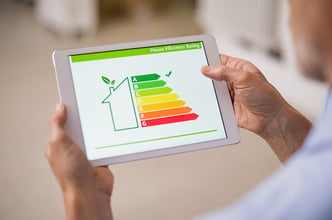
Would you tolerate an open hole in the side of your house? Without energy efficient windows, your home is nearly as exposed as it would be with a gaping hole. Of all the parts of your house, windows are among the most vulnerable to heat transfer; this can mean shelling out much more in energy bills. By investing in window efficiency, you can seal your abode off from the outside world, ensuring sustainability and affordability for the long haul.
Window Panes
The difference between windows that are energy efficient and inefficient begins with the glass. Traditionally, glass was highly vulnerable to heat transfer. Only by using the thickest panes of glass could one prevent outside conditions from leaking into the home. Unfortunately, such thick windows were typically very hard to see through, and created a serious risk of injury. But with modern insulated glass technology, you can virtually eliminate heat transfer without creating visibility or safety problems.
Insulated glass comes in a number of different forms. One of the most common is Low-E glass, or glass that is coated with a reflective metallic substance. This substance reflects heat back into your house in the winter while keeping it outside during the summer. Low-E glass also prevents ultraviolet light from passing through your windows, thereby protecting your skin, your eyes, and your upholstery from the negative effects of this radiation.
Besides Low-E glass, you also have the option of purchasing double pane windows. As their name implies, these windows consist of two panes separated by a space, which contains krypton or argon gas. The gas absorbs helps and prevents it from getting through the window, providing a similar economic and environmental benefit to that of Low-E glass. Double pane windows also have the benefit of helping keep sound out of your house—no small matter if you live in a city or other loud area.
Window Frames
As important as glass is for insulating against outside temperatures, it alone cannot fully seal your home off from exterior weather. Even the most efficient glass still has to connect to the window frame, and it is in the tiny spaces between the window and the frame through which heat can transfer. Luckily, by choosing the proper frame materials, you can keep this heat transfer to a minimum. The most efficient frame materials include:
- Wood - A natural source of energy efficiency, wood keeps most heat from moving into or out of your building. It is relatively difficult to maintain, however, making it a somewhat costly and time-consuming choice.
- Fiberglass - The most effective material for stopping heat transfer, fiberglass offers the highest levels of efficiency, but is expensive to install.
- Vinyl - Offering a good balance between efficiency and affordability, vinyl blocks the majority of heat.
Window Treatments
Besides the glass and frame, you should pay attention to what you lay over the window. The most efficient blinds, shutters, shades, and other covers can improve window efficiency levels by as much as 65 percent, all on their own. This can help make up for any shortcomings in the quality of your panes and framing. Some of the best window treatments for improving efficiency and insulating your home include:
- Honeycomb or Cellular shades - Honeycomb shades or cellular shades have honeycomb shaped cells that trap air within their pockets. This, in turn, provides a layer of insulation. For the maximum efficiency, try shades that have three cells rather than two. Cellular shades have the highest efficiency value, making them one of the best choices for energy efficient window treatments in your home.
- Solar shades - If you are looking for an insulating window treatment that doesn’t block your view, look no further than solar shades. With solar shades, a barrier between your home and harmful UV rays is created with an opaque material that still allows for an outside view. Fabrics vary in the weave or openness which allows different levels of light and UV rays to pass through. With a high openness factor and dark fabric, your view is clear and much of the outside light is blocked.
- Shutters - Shutters can save a fortune on energy costs. A lot of a home’s heated or cooled air can be lost through poorly insulated windows. Shutters tend to have far fewer gaps compared to other window treatments because they are installed tightly to the window frame. The custom fitted louvered adjustable panels prevent the transfer of warm or cold air from inside to the outdoors. During winter months, shutters create a barrier to keep you warm inside, and in the summertime, closed shutters block sunlight and the intrusion of hot, humid air.
- Motorized shades - Motorized shades are more than just convenient. They can help improve efficiency by being programmed to draw during the most extreme temperatures. For instance, in the summer, you can program the shades to close during the hottest parts of the day (typically from 10 am to 2 pm) in order to block the strongest, most harmful UV rays from heating your home and damaging furniture.
With the three-pronged protection of quality coverings, glass, and frames, your house will remain sustainable and efficient throughout the year. For more information on improving window efficiency and sustainability all over your home, contact All About Blinds & Shutters today!



